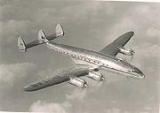
List of models of the Lockheed Constellation
Encyclopedia
The Lockheed Constellation
was a civil airliner and military transport built in the 1940s and 1950s; this is a list of its variants.
L-149
L-249
L-349
L-449
L-549
L-649
L-649A
L-749
L-749A
L-749B
L-849
L-949
L-1049
L-1049A
L-1049B
L-1049C
L-1049D
L-1049E
L-1049F
L-1049G
L-1049H
L-1049J
L-1149
L-1249A
L-1249B
L-1449
L-1549
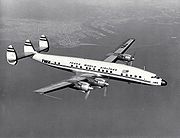 L-1649A Starliner
L-1649A Starliner
L-1649B
L-051
L-084
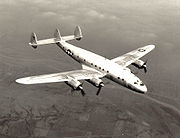 XB-30
XB-30
XC-69
C-69
C-69A
C-69B
C-69C-1
C-69D
XC-69E
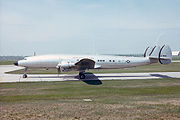
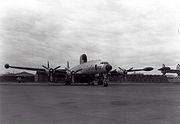
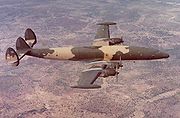 C-121A
C-121A
VC-121A
VC-121B
C-121C
JC-121C
NC-121C
RC-121C
TC-121C
VC-121C
EC-121D
NC-121D
RC-121D
VC-121E
YC-121F
C-121G
TC-121G
VC-121G
EC-121H
C-121J
EC-121J
NC-121J
VC-121J
EC-121K
JC-121K
NC-121K
EC-121L
EC-121M
WQC-121N
EC-121P
EC-121Q
EC-121R "BatCat"
NC-121S
EC-121T
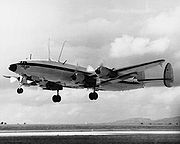
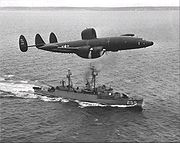 R7O-1
R7O-1
R7V-1
R7V-1P
R7V-2
PO-1W
PO-2W Warning Star
WV-1
WV-2 Warning Star
WV-2E
WV-2Q
WV-3
XW2V-1
Lockheed Constellation
The Lockheed Constellation was a propeller-driven airliner powered by four 18-cylinder radial Wright R-3350 engines. It was built by Lockheed between 1943 and 1958 at its Burbank, California, USA, facility. A total of 856 aircraft were produced in numerous models, all distinguished by a...
was a civil airliner and military transport built in the 1940s and 1950s; this is a list of its variants.
Civilian / Company designations
L-049Lockheed L-049 Constellation
The Lockheed L-049 Constellation was the first model of the Lockheed Constellation aircraft line. It entered service as the C-69 military transport aircraft during World War II for the United States Army Air Forces and was the first civilian version after the war...
- The L-049 was the original commercial airliner produced, although some earlier L-049s were begun as military transports and completed as airliners. L-649 aircraft followed, with more powerful engines, but all were soon upgraded to L-749 standard with long-range fuel tanks. 88 L-049, 14 L-649, and 131 L-749 were built, including conversions from earlier models and military versions. First 22 aircraft delivered as C-69 transports, first flight 9 January 1943
L-149
Lockheed L-049 Constellation
The Lockheed L-049 Constellation was the first model of the Lockheed Constellation aircraft line. It entered service as the C-69 military transport aircraft during World War II for the United States Army Air Forces and was the first civilian version after the war...
- L-049 conversion to include extra wing fuel tanks for a longer range. Production versions were planned for Pan Am, but none were ever produced.
L-249
Lockheed XB-30
-See also:-References:NotesBibliography* Stringfellow, Curtis K., and Peter M. Bowers. Lockheed Constellation. St. Paul, Minnesota: Motorbooks, 1992.-External links:*...
- Company designation for the XB-30 bomber.
L-349
Lockheed C-69 Constellation
The Lockheed C-69 Constellation was the first military version of the Lockheed Constellation aircraft line. It first flew in 1943, and only 22 were ever constructed for the United States Army Air Forces...
- Company designation for the C-69B.
L-449
Lockheed L-049 Constellation
The Lockheed L-049 Constellation was the first model of the Lockheed Constellation aircraft line. It entered service as the C-69 military transport aircraft during World War II for the United States Army Air Forces and was the first civilian version after the war...
- Unknown proposed civilian airliner version.
L-549
Lockheed C-69 Constellation
The Lockheed C-69 Constellation was the first military version of the Lockheed Constellation aircraft line. It first flew in 1943, and only 22 were ever constructed for the United States Army Air Forces...
- Company designation for the C-69C.
L-649
Lockheed L-649 Constellation
-See also:- Sources :CitationsBibliography* Breffort, Dominique. Lockheed Constellation: from Excalibur to Starliner Civilian and Military Variants. Paris: Histoire and Collecions, 2006. Print. ISBN 2915239622-External links:...
- R-3350Wright R-3350The Wright R-3350 Duplex-Cyclone was one of the most powerful radial aircraft engines produced in the United States. It was a twin row, supercharged, air-cooled, radial engine with 18 cylinders. Power ranged from 2,200 to over 3,700 hp , depending on the model...
-749C18BD engines with 2,500 hp (1,865 kW) each, seating for up to 81, first flight 19 October 1946
L-649A
Lockheed L-649 Constellation
-See also:- Sources :CitationsBibliography* Breffort, Dominique. Lockheed Constellation: from Excalibur to Starliner Civilian and Military Variants. Paris: Histoire and Collecions, 2006. Print. ISBN 2915239622-External links:...
- Reinforced landing gear and fuselage
L-749
Lockheed L-749 Constellation
-See also:- References :CitationsBibliography* Breffort, Dominique. Lockheed Constellation: from Excalibur to Starliner Civilian and Military Variants. Paris: Histoire and Collecions, 2006. Print. ISBN 2915239622-External Links:...
- 6,145 US gal (23,640 l) of fuel providing the capability for non-stop transatlantic flights, first flight 14 March 1947
L-749A
Lockheed L-749 Constellation
-See also:- References :CitationsBibliography* Breffort, Dominique. Lockheed Constellation: from Excalibur to Starliner Civilian and Military Variants. Paris: Histoire and Collecions, 2006. Print. ISBN 2915239622-External Links:...
- Reinforced landing gear and fuselage
L-749B
Lockheed L-749 Constellation
-See also:- References :CitationsBibliography* Breffort, Dominique. Lockheed Constellation: from Excalibur to Starliner Civilian and Military Variants. Paris: Histoire and Collecions, 2006. Print. ISBN 2915239622-External Links:...
- Turbine powered. Project cancelled due to the absence of a suitable powerplant.
L-849
Lockheed L-749 Constellation
-See also:- References :CitationsBibliography* Breffort, Dominique. Lockheed Constellation: from Excalibur to Starliner Civilian and Military Variants. Paris: Histoire and Collecions, 2006. Print. ISBN 2915239622-External Links:...
- Planned version of the L-749, which would have had Wright R-3350 TurboCompounds.
L-949
Lockheed L-749 Constellation
-See also:- References :CitationsBibliography* Breffort, Dominique. Lockheed Constellation: from Excalibur to Starliner Civilian and Military Variants. Paris: Histoire and Collecions, 2006. Print. ISBN 2915239622-External Links:...
- Speedfreighter combi version of the L-849 with an 18 ft 4in fuselage stretch.
L-1049
Lockheed L-1049 Super Constellation
The Lockheed L-1049 Super Constellation is an aircraft in the Lockheed Constellation aircraft line. The aircraft was Lockheed's response to the successful Douglas DC-6 airliner and first flew in 1950...
- First production version, 24 built.An 18 ft 4 in (5.59 m) stretched version with a maximum capacity of 109 passengers, square windows; all 1049C and later models had Turbo-Compound engines. Some later models had optional tip tanks. First flight 14 July 1951. 579 built, including military versions.
L-1049A
- Company designation for the WV-2, WV-3, EC-121D and RC-121D.
L-1049B
- Company designation for the R7V-1, RC-121C and VC-121E.
L-1049C
Lockheed L-1049 Super Constellation
The Lockheed L-1049 Super Constellation is an aircraft in the Lockheed Constellation aircraft line. The aircraft was Lockheed's response to the successful Douglas DC-6 airliner and first flew in 1950...
- Civil variant of the 1049B for 110 passengers with four R-3350-87ТС18DA-1 Turbo-compound engines with 3,250 hp (2,425 kW) each, 48 built
L-1049D
Lockheed L-1049 Super Constellation
The Lockheed L-1049 Super Constellation is an aircraft in the Lockheed Constellation aircraft line. The aircraft was Lockheed's response to the successful Douglas DC-6 airliner and first flew in 1950...
- Freight version of L-1049B with wing and fuselage modifications and a large cargo door, four built
L-1049E
Lockheed L-1049 Super Constellation
The Lockheed L-1049 Super Constellation is an aircraft in the Lockheed Constellation aircraft line. The aircraft was Lockheed's response to the successful Douglas DC-6 airliner and first flew in 1950...
- Passenger variant of the 1049D, 28 built
L-1049F
- Company designation for the C-121C.
L-1049G
Lockheed L-1049 Super Constellation
The Lockheed L-1049 Super Constellation is an aircraft in the Lockheed Constellation aircraft line. The aircraft was Lockheed's response to the successful Douglas DC-6 airliner and first flew in 1950...
- Advanced variant with four R-3350-972ТС18DA-3 engines with higher METO power, ability to carry wingtip fuel tanks, 102 built
L-1049H
Lockheed L-1049 Super Constellation
The Lockheed L-1049 Super Constellation is an aircraft in the Lockheed Constellation aircraft line. The aircraft was Lockheed's response to the successful Douglas DC-6 airliner and first flew in 1950...
- Passenger/freight convertible version of L-1049G with large cargo door, 53 built
L-1049J
Lockheed L-1049 Super Constellation
The Lockheed L-1049 Super Constellation is an aircraft in the Lockheed Constellation aircraft line. The aircraft was Lockheed's response to the successful Douglas DC-6 airliner and first flew in 1950...
- Planned L-1049G with the wings of the R7V-2.
L-1149
Lockheed L-1049 Super Constellation
The Lockheed L-1049 Super Constellation is an aircraft in the Lockheed Constellation aircraft line. The aircraft was Lockheed's response to the successful Douglas DC-6 airliner and first flew in 1950...
- A planned Allision turboprop version of the L-1049G and L-1049H.
L-1249A
- Company designation for the R7V-2 and YC-121F.
L-1249B
- Planned turboprop passenger version of the R7V-2/YC-121F.
- L-1349 unidentified. Dominique Breffort's book claims no design with the L-1349 designation ever existed, possibly due to superstitious belief reasons.
L-1449
Lockheed L-1649 Starliner
The Lockheed L-1649 Starliner was the last model of the Lockheed Constellation line. Powered by four Wright R-3350 TurboCompound engines, it was built at Lockheed's Burbank, California plant from 1956 to 1958.-Design and Development:...
- Proposed turboprop version of the L-1049G with a stretched fuselage and new wing.
L-1549
Lockheed L-1649 Starliner
The Lockheed L-1649 Starliner was the last model of the Lockheed Constellation line. Powered by four Wright R-3350 TurboCompound engines, it was built at Lockheed's Burbank, California plant from 1956 to 1958.-Design and Development:...
- Planned stretched version of the L-1449.

Lockheed L-1649 Starliner
The Lockheed L-1649 Starliner was the last model of the Lockheed Constellation line. Powered by four Wright R-3350 TurboCompound engines, it was built at Lockheed's Burbank, California plant from 1956 to 1958.-Design and Development:...
- Production version, R-3350-988TC18EA12 Turbo Cyclone engines with 3,400 hp (2,536 kW) each. Long-range passenger aircraft designed to compete with Douglas DC-7Douglas DC-7The Douglas DC-7 is an American transport aircraft built by the Douglas Aircraft Company from 1953 to 1958. It was the last major piston engine powered transport made by Douglas, coming just a few years before the advent of jet aircraft such as the Boeing 707 and Douglas DC-8.-Design and...
C. The standard radome for the weather radar extends total length by 2 ft 7 in (0.78 m) over L-1049 without radome. New thin-section wing with a straight taper, and much larger fuel capacity giving a ferry range of over 6,880 mi (11,080 km), first flight 10 October 1956. 44, including the prototype, were built.
L-1649B
Lockheed L-1649 Starliner
The Lockheed L-1649 Starliner was the last model of the Lockheed Constellation line. Powered by four Wright R-3350 TurboCompound engines, it was built at Lockheed's Burbank, California plant from 1956 to 1958.-Design and Development:...
- Planned turboprop version of the L-1649A.
L-051
Lockheed XB-30
-See also:-References:NotesBibliography* Stringfellow, Curtis K., and Peter M. Bowers. Lockheed Constellation. St. Paul, Minnesota: Motorbooks, 1992.-External links:*...
- Original company designation for the XB-30 project.
L-084
- The XW2V-1 was a planned radar version of the WV-2 with the Starliner's wings for the US Navy. It would have included four Allison T56-A8 engines and missiles for protection against attackers. Considerably different than its predecessors, given the production designation Lockheed L-084.
Military designations

Lockheed XB-30
-See also:-References:NotesBibliography* Stringfellow, Curtis K., and Peter M. Bowers. Lockheed Constellation. St. Paul, Minnesota: Motorbooks, 1992.-External links:*...
- Bomber version of the C-69. Was given model designation L-051 and later L-249.
XC-69
Lockheed C-69 Constellation
The Lockheed C-69 Constellation was the first military version of the Lockheed Constellation aircraft line. It first flew in 1943, and only 22 were ever constructed for the United States Army Air Forces...
- Designation for the prototype Constellation. One built. The C-69 was the original military transport version for the USAAF. All aircraft built during World War II were pressed into military service under this designation.
C-69
Lockheed C-69 Constellation
The Lockheed C-69 Constellation was the first military version of the Lockheed Constellation aircraft line. It first flew in 1943, and only 22 were ever constructed for the United States Army Air Forces...
- Original troop transport version. Almost all of this type were converted into L-049 airliners. 22 were built.
C-69A
Lockheed C-69 Constellation
The Lockheed C-69 Constellation was the first military version of the Lockheed Constellation aircraft line. It first flew in 1943, and only 22 were ever constructed for the United States Army Air Forces...
- Proposed long range troop version of the C-69.
C-69B
Lockheed C-69 Constellation
The Lockheed C-69 Constellation was the first military version of the Lockheed Constellation aircraft line. It first flew in 1943, and only 22 were ever constructed for the United States Army Air Forces...
- Proposed long range troop version of the C-69 designed to carry B-29 Superfortress engines to ChinaChinaChinese civilization may refer to:* China for more general discussion of the country.* Chinese culture* Greater China, the transnational community of ethnic Chinese.* History of China* Sinosphere, the area historically affected by Chinese culture...
. Was given model designation L-349.
C-69C-1
Lockheed C-69 Constellation
The Lockheed C-69 Constellation was the first military version of the Lockheed Constellation aircraft line. It first flew in 1943, and only 22 were ever constructed for the United States Army Air Forces...
- VIP transport aircraft, later designated ZC-69C-1. Only one aircraft was produced. Was given model designation L-549.
C-69D
Lockheed C-69 Constellation
The Lockheed C-69 Constellation was the first military version of the Lockheed Constellation aircraft line. It first flew in 1943, and only 22 were ever constructed for the United States Army Air Forces...
- Proposed VIP transport version.
XC-69E
Lockheed C-69 Constellation
The Lockheed C-69 Constellation was the first military version of the Lockheed Constellation aircraft line. It first flew in 1943, and only 22 were ever constructed for the United States Army Air Forces...
- Prototype XC-69 converted into an engine testbed. It was powered by 4 Pratt & Whitney R-2800Pratt & Whitney R-2800The Pratt & Whitney R-2800 Double Wasp is a two-row, 18-cylinder, air-cooled radial aircraft engine with a displacement of 2,804 in³ , and is part of the long-lived Wasp family....
Double Wasp engines.



- The C-121 was the military transport version of improved L-749 introduced in 1948. Reinforced floor, cargo door in port rear fuselage
VC-121A
- VIP transport aircraft, converted from the C-121A
VC-121B
- VIP transport for use by the President of the United States of America
C-121C
- R7V-1 with R-3350-34 engines with 3,400 hp (2,536 kW) each, based on L-1049
JC-121C
- Two C-121C and one TC-121C used as avionics testbeds
NC-121C
- One C-121C converted for permanent use as a testbed
RC-121C
- USAF long-range airborne radar analogous to Navy's WV-2
TC-121C
- Nine RC-121Cs Converted as AEW trainers, subsequently became EC-121C
VC-121C
- VIP version of C-121C. Total 4.
EC-121D
- Big Eye/College Eye/Disco early warning variant, originally designated RC-121D
NC-121D
- WV-2 converted to observe high speed objects in the atmosphere nicknamed the "Tripple Nipple"
RC-121D
- WV-2 with wingtip fuel tanks, later redesignated EC-121D
VC-121E
- VIP transport for use by the President of the United States of America
YC-121F
- Two prototype R7V-1 with Pratt & Whitney T34-P-6 turboprops with 6,000 shp (4,476 kW) each
C-121G
- 32 Navy R7V-1 delivered to USAF
TC-121G
- Designation given to 9 C-121G converted into trainers
VC-121G
- One C-121G given the role as a temporary VIP Transport
EC-121H
- 42 EC-121D with upgraded electronics
C-121J
- Redesignated Navy R7V-1
EC-121J
- 2 EC-121D with upgraded electronics
NC-121J
- 7 C-121J modified to send television broadcasts to troops in Vietnam
VC-121J
- 4 C-121J converted for VIP use. One served with the Blue AngelsBlue AngelsThe United States Navy's Navy Flight Demonstration Squadron, popularly known as the Blue Angels, was formed in 1946 and is currently the oldest formal flying aerobatic team...
.
EC-121K
- Redesignated Navy WV-2 Warning Star
JC-121K
- One EC-121K used as an avionics testbed
NC-121K
- EC-121K used by the Navy
EC-121L
- Redesignated Navy WV-2E
EC-121M
- Redesignated Navy WV-2Q
WQC-121N
- Redesignated Navy WV-3
EC-121P
- EC-121K equipped for anti-submarine warfare
EC-121Q
- EC-121D with upgraded electronics
EC-121R "BatCat"
- EC-121K and EC-121P equipped to process signals from seismic instruments
NC-121S
- Electronic warfare and reconnaissance version
EC-121T
- Upgraded radar; One exeample is on display at Peterson Air and Space MuseumPeterson Air and Space MuseumPeterson Air and Space Museum is located inside Peterson Air Force Base, Colorado Springs, Colorado. Access to the museum is limited due to security concerns, so tour groups should contact the museum curator...
, EC-121T photo.


- The original US Navy designation of the R7V-1 based on L-1049D, R-3350-91 engines with 3,250 hp (2,425 kW) each
R7V-1
- Re-desgination of the R7O-1. Later redesignated C-121J
R7V-1P
- One R7V-1 modified for Arctic use
R7V-2
- Four prototypes with Pratt & Whitney YT34-P-12A turboprops of 4,140 shp (3,088 kW) each. Two were delivered as YC-121F prototype aircraft (see above).
PO-1W
- Two maritime patrol aircraft equipped with search radar based on L-749, later re-designated WV-1.
PO-2W Warning Star
- Long-range airborne radar aircraft, R-3350-34 or R-3350-42 engines with 3,400 hp (2,536 kW) each, based on L-1049, later re-designated WV-2.
WV-1
- Re-designation of the PO-1W.
WV-2 Warning Star
- Re-designation of the PO-2W. Later re-designated EC-121K.
WV-2E
- Experimental version of WV-2 modified to carry a rotating radar dome similar to that of the Boeing E-3 SentryE-3 SentryThe Boeing E-3 Sentry is an airborne warning and control system developed by Boeing as the prime contractor. Derived from the Boeing 707, it provides all-weather surveillance, command, control and communications, and is used by the United States Air Force , NATO, Royal Air Force , French Air Force...
. Later redesignated EC-121L.
WV-2Q
- WV-2 equipped for electronic warfare, later redesignated EC-121M.
WV-3
- Eight aircraft equipped for weather reconnaissance. Later re-designated WQC-121N.
XW2V-1
- The XW2V-1 was a planned radar version of the WV-2 with the Starliner's wings for the US Navy. It would have included four Allison T56-A8 engines and missiles for protection against attackers. Considerably different than its predecessors, given the production designation Lockheed L-084.
Sources
- C-69/C-121 - US Warplanes.net
- Breffort, Dominique. Lockhead Constellation: from Excalibur to Starliner Civilian and Military Variants. Paris: Histoire and Collecions, 2006. Print. ISBN 2915239622

